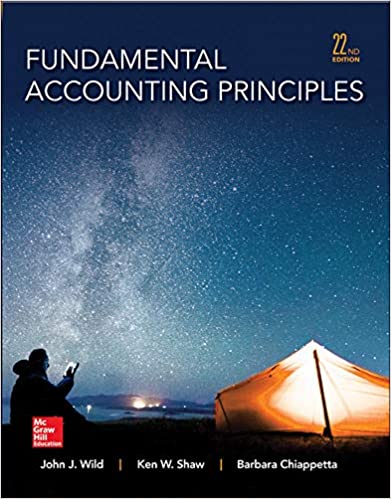
Fundamental Accounting Principles 22th Edition by John Wild ,Ken Shaw,Barbara Chiappetta
Edition 22ISBN: 978-0077862275
Fundamental Accounting Principles 22th Edition by John Wild ,Ken Shaw,Barbara Chiappetta
Edition 22ISBN: 978-0077862275 Exercise 20
(If the Working Papers that accompany this book are not available, omit this comprehensive problem. ) Assume it is Monday, May 1, the first business day of the month, and you have just been hired as the accountant for Colo Company, which operates with monthly accounting periods. All of the company's accounting work is completed through the end of April and its ledgers show April 30 balances. During your first month on the job, the company experiences the following transactions and events (terms for all its credit sales are 2/10, n/30 unless stated differently):
May 1 Issued Check No. 3410 to S P Management Co. in payment of the May rent, $3,710. (Use two lines to record the transaction. Charge 80% of the rent to Rent Expense-Selling Space and the balance to Rent Expense-Office Space.)
2 Sold merchandise on credit to Hensel Company, Invoice No. 8785, for $6,100 (cost is $4,100).
2 Issued a $175 credit memorandum to Knox Co. for defective (worthless) merchandise sold on April 28 and returned for credit. The total selling price (gross) was $4,725.
3 Received a $798 credit memorandum from Peyton Products for the return of merchandise purchased on April 29.

Required
1. Enter these transactions in a sales journal, a purchases journal, a cash receipts journal, a cash disbursements journal, or a general journal as illustrated in this chapter (number all journal pages as page 2).
Post when instructed to do so. Assume a perpetual inventory system.
2. Prepare a trial balance in the Trial Balance columns of the work sheet form provided with the working papers. Complete the work sheet using the following information for accounting adjustments.
a. Expired insurance, $553.
b. Ending store supplies inventory, $2,632.
c. Ending office supplies inventory, $504.
d. Depreciation of store equipment, $567.
e. Depreciation of office equipment, $329.
Prepare and post adjusting and closing entries.
3. Prepare a May 2015 multiple-step income statement, a May 2015 statement of owner's equity, and a May 31, 2015, classified balance sheet.
4. Prepare a post-closing trial balance. Also prove the accuracy of subsidiary ledgers by preparing schedules of both accounts receivable and accounts payable.
May 1 Issued Check No. 3410 to S P Management Co. in payment of the May rent, $3,710. (Use two lines to record the transaction. Charge 80% of the rent to Rent Expense-Selling Space and the balance to Rent Expense-Office Space.)
2 Sold merchandise on credit to Hensel Company, Invoice No. 8785, for $6,100 (cost is $4,100).
2 Issued a $175 credit memorandum to Knox Co. for defective (worthless) merchandise sold on April 28 and returned for credit. The total selling price (gross) was $4,725.
3 Received a $798 credit memorandum from Peyton Products for the return of merchandise purchased on April 29.

Required
1. Enter these transactions in a sales journal, a purchases journal, a cash receipts journal, a cash disbursements journal, or a general journal as illustrated in this chapter (number all journal pages as page 2).
Post when instructed to do so. Assume a perpetual inventory system.
2. Prepare a trial balance in the Trial Balance columns of the work sheet form provided with the working papers. Complete the work sheet using the following information for accounting adjustments.
a. Expired insurance, $553.
b. Ending store supplies inventory, $2,632.
c. Ending office supplies inventory, $504.
d. Depreciation of store equipment, $567.
e. Depreciation of office equipment, $329.
Prepare and post adjusting and closing entries.
3. Prepare a May 2015 multiple-step income statement, a May 2015 statement of owner's equity, and a May 31, 2015, classified balance sheet.
4. Prepare a post-closing trial balance. Also prove the accuracy of subsidiary ledgers by preparing schedules of both accounts receivable and accounts payable.
Explanation

This question doesn’t have an expert verified answer yet, let Examlex AI Copilot help.
Fundamental Accounting Principles 22th Edition by John Wild ,Ken Shaw,Barbara Chiappetta
Why don’t you like this exercise?
Other Minimum 8 character and maximum 255 character
Character 255


